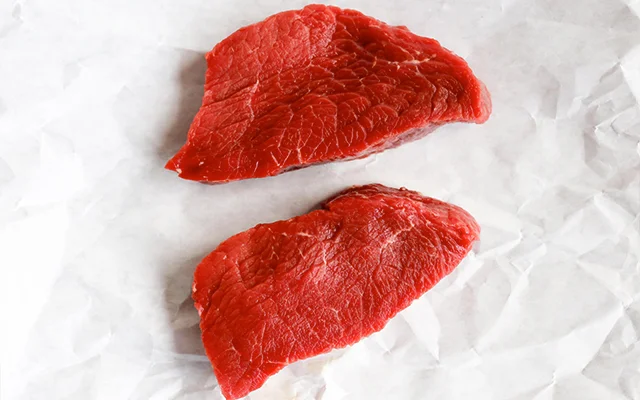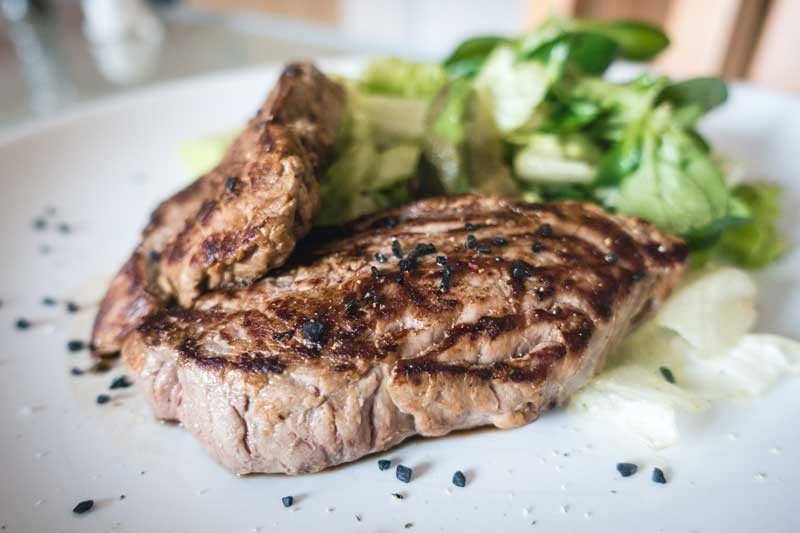
Topside Beef
All you ever wanted to know about topside beef steak
What is Topside Beef?
Not too dissimilar to the silverside, Topside beef steaks are strong in flavour and low in price! Coming from the hindquarter, the meat is very, very lean. That means the marbling is quite minimal, but that’s why butchers tend to leave on a thin layer of fat on one side to help develop its flavour while cooking. Because it’s naturally tough, Topside beef steaks are more often not tenderised or pounded using a tenderiser. Once gone through this process, you’re left with a thin slice of meat! Be sure to either bake or pan-fry!
Buy Sustainable Topside Beef SteakNutritional value of Topside beef steak
Though not every topside beef steak will be exactly the same, the table below provides the average nutritional facts of the standard topside beef steak! Have a look below:
| NUTRITIONAL FACTS | |
| Serving size of 100g | |
| Calories | 124 |
| Per Serving | % Daily Value |
| Protein 22g | 45% |
| TOTAL FAT 4g | 5% |
| Saturated Fat 2g | 6% |
| Sodium44mg | 2% |
| Potassium | 358mg |
| Cholesterol | 35mg |
| Iron | 1mg |
| Carbohydrates 0g | 0% |
| Dietary Fiber 0g | 0% |
| Sugars | 0g |
Best practices for choosing Topside beef
Pasture raised
One of the very first things to look for when selecting topside beef steak is whether the beef comes from a cow that was pasture-raised. Pasture-raised cows are those which have spent the majority of their lives on green pastures (or at least with free access to it) rather than being confined indoors. Cows that have been pasture-raised have, on average, a much more naturally nutritious grass-based diet and lived lives that are happier and less stressful – both of which translate to the highest quality of beef!
Though you might find the term 'pasture-raised' on a topside beef label, it's important to note that neither the UK nor EU regulations have clarified requirements that producers must follow to be able to mark their products as so; there isn't even a clear definition of what the term 'pasture' means. The only way to be able to determine this is to buy your topside beef steaks from a source that gives you complete transparency into the farmer, farm and farming processes that have produced the topside beef you're considering to buy.
Prev. antibiotic free
This is an easy one in theory, but a little more complicated in practice. Where the cow that has produced your topside beef steak was grain-fed, it's likely that is was reared in an indoor feedlot, crowded with a lot of other cows. In such settings, the odds of the inception and spreading of illness of infection are very high. As a result, to protect against illness farmers of feedlot cattle have come to intensively use what are called 'preventative antibiotics' – a ‘carpet bomb’ antibiotic that preemptively helps avoid disease or illnesses. While the intention may be good, over time such practices actually lead to the lowering of health, safety and welfare standards for cows. What's more, the antibiotics that the cows are being consumed end up in their beef, which when consumed by humans, has been found to increase our resistance to antibiotics that are crucial to protecting against dangerous diseases. Rather than using preventative antibiotics, you want to make sure the topside beef you're buying is coming from a farm that ensures high degrees of animal health, safety and sanitation to avoid illness or disease all together; only ever using antibiotics in urgent cases of illness!
Again, understanding the specific antibiotic practices of the farm your topside beef is coming from can be very challenging – especially when buying your beef from supermarkets that typically don't - or can't – provide transparent information on where the beef they're selling comes from let alone how the cows that produced it were treated. In such cases, we recommend buying topside beef from sources that can provide certainty and transparency on such issues.
Storing Topside beef
How long you can store topside beef really varies depending on where you store it and how it has been packaged! Though these are roundabout figures, check out the table below to get an indication of how long you can store topside beef!
Fridge vs Freezer
| Fridge | Freezer | |
| Paper Wrap / Plastic Bag or Tray | 1 - 2 days | 6 - 12 months |
| Vacuum Packaging | 2 weeks | 2 - 3 years |
Obviously, vacuum packing your topside beef steak allows for it to be stored for much longer in both the fridge and the freezer! To learn more about what vacuum packing, how it works, and understand its wider benefits, check out our Deep Dive into Vacuum Packing Meat.
Defrosting Topside beef
If your topside beef has been frozen and packaged using a paper wrap, plastic bag, or some sort of tray, the best way to defrost it is to remove it from the freezer to fridge one day before you plan to cook it so it can slowly thaw. Tip: Place a plate or tray underneath, to catch any melting ice.
Alternatively, if your topside beef is vacuum packed, you can simply take it out the freezer and place it in a bowl filled with cold tap water! Almost unknown in the UK, this method will have your topside beef steak defrosted in about 15 - 20 minutes!
You've probably heard that you can defrost your meat using a microwave. Whilst this is possible when there are no alternatives, we strongly recommend against this method as it critically deteriorates the quality of your meat, making it very dry and tough!
Buy Vacuum Packed Topside Beef SteakHow to cook Topside beef Steak

Below we include a handy excerpt on how to cook topside steak from our master class on cooking topside beef steak. For more information on preparation steps, ingredients and recommended sides check it out here!
- Heat up 2 tablespoons of olive oil on a pan, sitting on a high temperature.
- Once the pan has just started to smoke, carefully place the topside beef steaks into the frying pan.
- Turn the Topside beef steaks over every minute — making sure each side has been cooked for 3 minutes or until beautifully brown and with an internal temperature of 50 - 57 degrees for medium-rare.
- Take the steaks off the pan and wrap in aluminium foil
- Allow the cooked topside beef steaks to rest for about 7 minutes.
- Cut against the grain and serve!
What to serve with Topside beef Steak
We recommend serving your topside beef steaks with a watercress salad, mustard sauce and croutons! Yum! Enjoy!